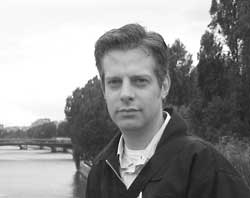Although it is unassuming, particularly within the context of Robert Rauschenberg’s vast and ambitious oeuvre, Postcard Self-Portrait, Black Mountain (II) of 1952 is among the most evidently carefully staged works of the artist’s career. In it, an expanse of floor taking up more than half the image is topped by two thin, striped mattresses on which Rauschenberg lies in dark clothing, his head on an equally dark pillow, body tightly squeezed into the upper portions of the frame. Other of Rauschenberg’s photographs from this time willfully, and seemingly effortlessly, transgress their edges, an effect particularly emphasized in an image of a marshy lakeside that seems to spread entropically beyond all four of the photograph’s sides.1 In Postcard Self-Portrait, Black Mountain (II), on the contrary, Rauschenberg has wedged himself not only into the confines of the photograph but also beneath the lower portion of one of his Black paintings, which seems to press down on him from above. The artist’s right knee just grazes the painting’s bottom edge, while his hands, chest, and head vigilantly avoid blocking our view, helping to counter any effect of spatial depth that might be created between him and the wall behind. The left and right ends of the mattresses have been cut off by the frame so as not to reveal their width, causing them to register primarily as horizontal striations across the pictorial surface. Countering the camera’s built-in perspective is clearly Rauschenberg’s goal. The entire visual field seems upended, made to resemble something like a section cut through sedimentary rock, the artist’s body encapsulated within it like some sort of fossil. Only a slight blur across Rauschenberg’s face conveys even a hint of possible motion; everything else is locked in and frozen still.
The photograph’s tour de force is its verticalization of the studio floor, which comes to resemble an abstract block of gray. Those few feet closest to the viewer lack focus (likely on account of the camera being placed on or very near to the floor), which only resolves in a narrow band just below the bottommost mattress, where one can make out what appear to be dust motes. A washy expanse of smudging, including possible traces of fingerprints, lightly stains the emulsion in the photograph’s lower quadrant, lending the floor an additionally contradictory character, for it reads not only as both horizontal and vertical but also as both hard as cement and ever so slightly atmospheric, even liquid. Cover the top portion of the image and one could be looking at a reflection on shallow water, an effect Rauschenberg captured in another photograph, Untitled [Folly Beach, S.C.] (ca. 1952, fig. 2), which, incidentally, also retains visible smudging in its emulsion.2
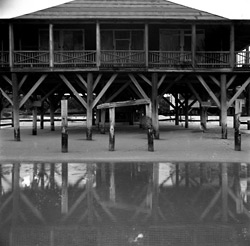
It is in the relationship of vertical to horizontal, and of atmospheric spatiality to impenetrable solidity, that we come to the central paradox and potential interest of this modest picture. For it was in the programmatic separation of these two pairs of attributes that art historian Leo Steinberg delineated the most influential critical concept ever applied to Rauschenberg’s production: the “flatbed picture plane.”3 This new conception of a pictorial artwork, which according to Steinberg developed in the 1950s and rose to prominence in the following decade, took the form of a symbolically hard, seemingly impenetrable surface atop which any range of materials could be “received, printed, impressed—whether coherently or in confusion.”4 Obdurate and durable, its orientation was rotated ninety degrees away from erect human posture—abjuring the linear perspective that, since the time of Renaissance art theorist Leon Battista Alberti, has metaphorically likened the painted canvas to a window—to lay it firmly on a horizontal ground. Steinberg essayed many metaphors for this new pictorial orientation. In addition to desktop, dashboard, chart, map, printer’s proof, and bed (the last literally depicted, of course, in the mattresses within this photograph), Steinberg often cited precisely what takes up the majority of Rauschenberg’s Postcard Self-Portrait, Black Mountain (II): “an unswept floor.”5
Steinberg’s notion of the flatbed had to do specifically with painting, particularly that executed on the scale that had been achieved with Abstract Expressionism (which is why he excluded the more compact collages of Pablo Picasso, Georges Braque, and Kurt Schwitters). Photography, when Steinberg discussed it at all, served as the flatbed’s diametric opposite. The photographs pasted across Rauschenberg’s Combine paintings and Combines were, for Steinberg, perilous, since they “threatened to evoke a topical illusion of depth.”6 This was something, he argued, that Rauschenberg assiduously countered with the addition of casual paint strokes across the surface of his embedded photographs, “to recall [the picture plane’s] irreducible flatness.”7 In actuality, however, Rauschenberg played a bit more daringly with the spatial effects engendered by photography, pressing photographs (and fine art reproductions) into service as markers of perspectival illusionism so as to pit them against the Combines’ otherwise flatbed expanses (not unlike the manner in which he utilized the actual openings he sometimes incorporated into such works). Note, for example, the sense of depth evoked by the banquet scene in the bottom right corner of Hazard (1957, fig. 3), which Rauschenberg juxtaposed with a similar photographic group portrait to its left, wherein the perspectival illusion has been undermined (in precisely the manner Steinberg describes) by means of a translucent scumble of white paint.
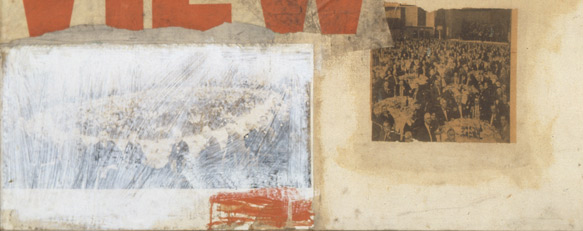
Such subtleties are often overlooked in even the most nuanced discussions of Rauschenberg’s production. Although Steinberg, for polemical reasons, strongly advanced the notion of the flatbed picture plane, he nonetheless also stressed the need for a high level of attentive observation throughout his able defense of the complexities of Old Master painters against Clement Greenberg’s reductive oversimplifications. In her essay “Perpetual Inventory,” Rosalind Krauss provides an appropriately sophisticated discussion of Rauschenberg’s understanding of photography as expressed in the early 1960s, when he adopted the silkscreen technique. No doubt derived in part from the type of juxtapositions found in Combines such as Hazard, Rauschenberg’s conception of the photograph was, according to Krauss, “layered: a depth and a surface forced into some kind of contact.”8 Rauschenberg’s primary example of such layering, as put forward in his manifesto-like 1963 photo-essay “Random Order,” was “a dirty or foggy window,” the translucency of which at one and the same time emphasizes the flatness of the glass and allows one to see through it into depth.9 As though looking through a veil, such a situation “mak[es] what is outside appear to be projected on to the window plane.”10 As I’ve noted elsewhere, Rauschenberg’s neologism window plane—in its combination of the pictorial transparency associated with a window pane and the flat opacity of the modernist picture plane—is a particularly concise and appropriate designation of his concerns.11
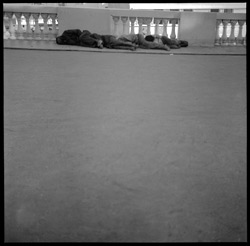
Postcard Self-Portrait, Black Mountain (II), however, plays with issues of flatness and depth in a somewhat different fashion. Unlike the palimpsestic, dirty-window effect described in “Random Order,” Postcard Self-Portrait, Black Mountain (II) seems to do everything it can to force all depicted elements onto the same plane, setting every inch of the represented field, as much as photographically possible, into a stark coincidence with the surface of the paper onto which it has been printed. Rauschenberg repeated the effect at least once, in a photo of several men sleeping against a stone balustrade, the street in front of them upended to read largely as parallel to the picture plane (fig. 4).12 Like Rauschenberg on his mattresses, the three men are confined to the image’s upper reaches, the balustrade and sidewalk reinforcing the horizontal line of their bodies (set, in this case, within the square format produced by Rauschenberg’s Rolleicord twin-lens reflex camera).
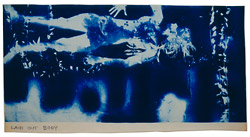
Postcard Self-Portrait, Black Mountain (II) relates equally closely to Rauschenberg and Susan Weil’s blueprint paper photograms (1949–50), analogues of cameraless photography wherein human silhouettes express what Steinberg called “the physical material of plans” more than the perspectival vistas of conventional photographs.13 (Indeed, the title written along the lower edge of one, Blueprint Portfolio II. Laid Out Body [ca. 1950, fig. 5], could well have been used for the photograph under discussion here.)14 Like the blueprints, Rauschenberg’s Postcard Self-Portrait, Black Mountain (II) should be counted among the earliest intimations of the development of the flatbed picture plane. Yet at the same time it also importantly evinces, if not precisely the kind of pictorial layering discussed in “Random Order,” nonetheless an important duality. For the photograph’s two slightly unequal halves (the studio floor, on the one hand; and the stack of mattresses, the artist’s body, and the black painting, on the other), despite their initial spatial coherence, subtly but persistently destabilize each other. If one reads the floor as uprighted into verticality, flattened onto the same plane as the physical photograph itself, then Rauschenberg and the mattresses read as horizontal, as though the artist had installed himself on a shelf jutting back from the wall. Conversely, if one forces oneself to notice the actual horizontality of the floor, receding away from the camera into depth, then the elements above it (mattresses, etc.) must be recognized as ascending at a ninety-degree angle from this ground plane. It is as if there is a fold or hinge at the bottom of the mattresses that connects two otherwise incommensurable visual realities. Verticality and horizontality, flatness and depth, planarity and spatiality, even abstraction (in the monochrome gray floor plane) and representation coexist in the photograph in a subtly contradictory yet no less apparently continuous manner.
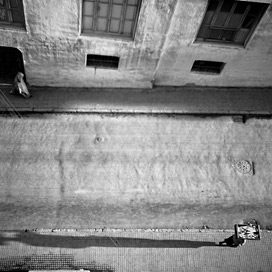
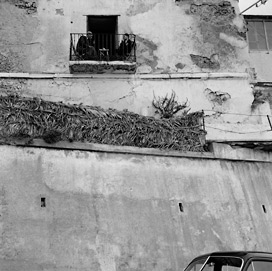
7. Robert Rauschenberg, Tangier, 1952. Gelatin silver print, 15 x 15 in. (38.1 x 38.1 cm). © Robert Rauschenberg Foundation / Licensed by VAGA, New York, NY


7. Robert Rauschenberg, Tangier, 1952. Gelatin silver print, 15 x 15 in. (38.1 x 38.1 cm). © Robert Rauschenberg Foundation / Licensed by VAGA, New York, NY
I’m aware that I am pressing fairly hard on this single modest photograph, and that the nuances I’m insisting on may not carry enough force to overcome the initial impression of one-dimensionality that prevails upon a casual glance. Yet looking at Postcard Self-Portrait, Black Mountain (II) in this manner allows for a recognition of similar concerns in other Rauschenberg photographs of the time, such as two taken in Tangier that seem to form a complementary pair. The first, Tangier Street (II) (1952, fig. 6), shot from high above, visually tilts the street and the cobblestone sidewalks to either side of it upward, from which the actually vertical building facade at the top seems to careen forward at an unstable angle.15 The second, Tangier (1952, fig. 7), showing two men conversing on a balcony (perhaps like that from which the first photograph was shot), devotes the bottom half of the image to an expanse of plastered wall that, despite all visual evidence to the contrary (including the balcony at the top and the windshield and roof of a car caught in the bottom corner), seems to fall back into the horizontality of something like a road.16
Such observations help to emphasize the fact that, more than any literal orientation of the canvas upon the ground—as famously and uniquely effected by Rauschenberg in Monogram (1955–59)—it was precisely an unstable switching between verticality and horizontality that Steinberg defined as the central concern of the flatbed picture plane. “To repeat,” he emphasized, “it is not the actual physical placement of the image that counts. . . . What I have in mind is the psychic address of the image, its special mode of imaginative confrontation.”17 This is why, he explained, “perhaps Rauschenberg’s profoundest symbolic gesture came in 1955 when he seized his own bed, smeared paint on its pillow and quilt coverlet, and uprighted it against the wall. There, in the vertical posture of ‘art,’ it continues to work in the imagination as the eternal companion of our other resource, our horizontality.”18
Rauschenberg may have been thinking back to Postcard Self-Portrait, Black Mountain (II) when he conceived of Bed (1955), and not only on account of the evident iconographic connections. For in a similarly concise and specific manner, Rauschenberg’s photograph effects a subtle but persistent interplay of horizontality and verticality, surface and depth, the flatness of the represented scene and the flatness of the actual pictorial support. If this photograph can be said to prefigure the concerns of the flatbed picture plane, it should also stand to nuance any overly reductive conception of that most cited of Steinberg’s critical concepts. For Rauschenberg’s Postcard Self-Portrait, Black Mountain (II), which plays with its medium’s inherent illusion of depth even as it deploys great ingenuity in countering it, achieves a “potency” that, to quote Steinberg, “depends—like the appreciation of counterpoint or of puns—on the spectator’s ability to register two things in concert.”19
Notes
- On this aspect of Rauschenberg’s photography, see Branden W. Joseph, “The Gap and the Frame,” October 117 (Summer 2006): 44–70; Rauschenberg’s lakeside photograph is reproduced on page 63. It is also reproduced in Nicholas Cullinan, Robert Rauschenberg: Photographs 1949–1962, ed. Susan Davidson and David White (New York: Distributed Art Publishers, 2011), 95.
- Cullinan, Robert Rauschenberg: Photographs 1949–1962, 103.
- Leo Steinberg, “Reflections on the State of Criticism,” in Robert Rauschenberg, ed. Branden W. Joseph (Cambridge, MA: MIT Press, 2002), 7–37. Previously published as “Reflections on the State of Criticism,” Artforum 10, no. 7 (March 1972): 37–49.
- Ibid., 28.
- Ibid., 30–32.
- Ibid., 32.
- Ibid.
- Rosalind Krauss, “Perpetual Inventory,” in Robert Rauschenberg: A Retrospective, ed. Walter Hopps and Susan Davidson (New York: Solomon R. Guggenheim Museum, 1997), 219.
- Robert Rauschenberg, “Random Order,” Location 1, no. 1 (Spring 1963): 28.
- Ibid.
- Joseph, “The Gap and the Frame,” 55.
- Ibid., 56.
- Steinberg, “Reflections on the State of Criticism,” 29.
- Robert Rauschenberg and Susan Weil, Blueprint Portfolio II (ca. 1950), reproduced in Cullinan, Robert Rauschenberg: Photographs 1949–1962, 61.
- Cullinan, Robert Rauschenberg: Photographs 1949–1962, 141.
- Ibid., 147.
- Steinberg, “Reflections on the State of Criticism,” 28.
- Ibid., 34.
- Ibid., 18.
